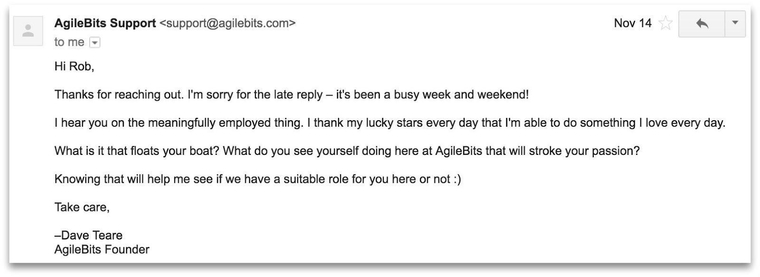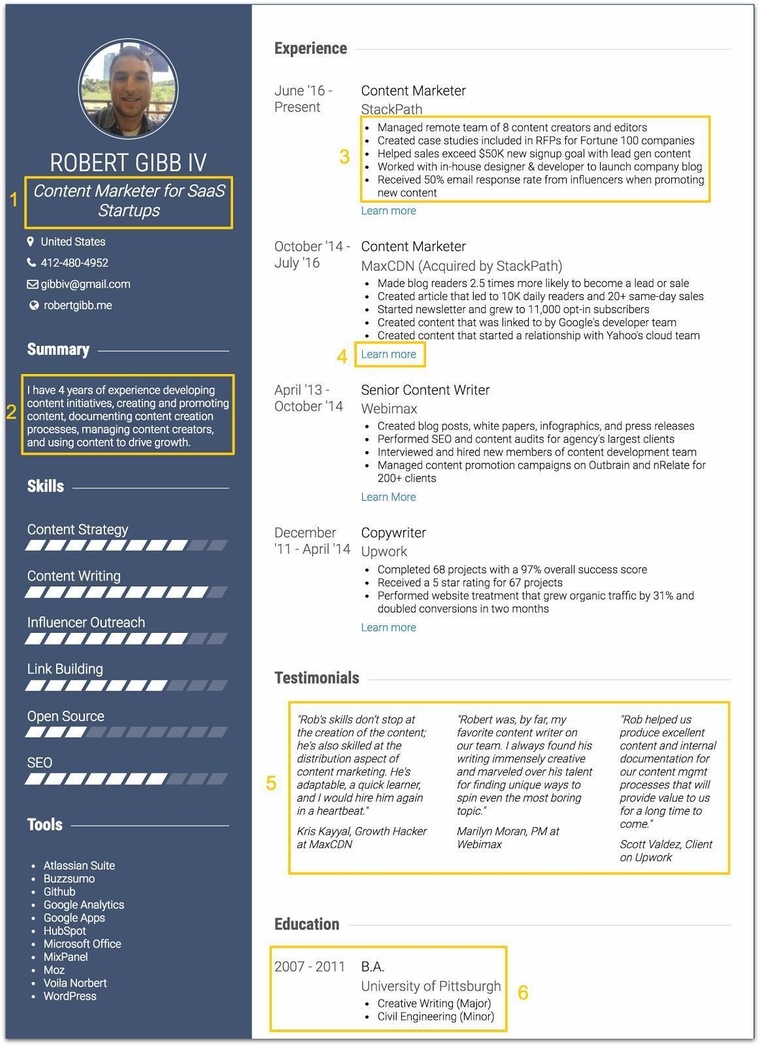
How to Create a Resume Start-ups Love

Let’s face it, start-ups typically do not review resumes the same way big companies do. The person reviewing your resume at a big company is often a recruiter, yet the person reviewing your resume at a startup is often the co-founder and trust me they are FAR more invested. Unfortunately, this was news to me.
During my first week of applying for jobs after leaving my previous position for something more meaningful, I sent my resume to companies of all sizes and I quickly saw a trend. From the smaller companies I applied to, I was receiving responses directly from the founder.

Responses like this made me rethink how I should present myself to potential employers as I continued to apply to more jobs.
While I was comfortable with how I was applying to companies and getting the responses/validation like the one above, I knew that my resume needed some work. After-all, II didn’t just want replies, I wanted interviews. I wanted to prime people with the idea that I was the only person for the job and I soon learned that my resume was either going to break down the wall or quickly erect one.
To create a resume that communicated my relevant experience for that ideal position, I had to first narrow down my goal and target employer. Did I want a job at a start-up or was size not an issue? Was my resume going to be filtered through HR, someone directly responsible for creating the company, by and ATS or a third-party recruiter?
Suggested links
- Our collection of 500+ professional resume examples.
- Our gallery of 20 resume templates.
Why Applying to Start-ups Is NOT Business as Usual
What I quickly learned is that the majority of businesses that were interested in me were usually going through seed/series funding or were being completely bootstrapped. Financials aside, almost all of them were in their initial stages of growth and I liked this. It signaled opportunity. Plus, nearly all of these startups were remote-friendly which was a must for me as I’m traveling the world with We Roam in 2017.
This brings me to insight #1: Know your audience. Because only start-ups were responding to me with any real promise, I stopped applying to roles at larger, well-known companies that attracted a lot of applicants. This saved me a lot of time and, more importantly, from a false hope of a reply.
This made me think back to a few years ago, when Google made the number of applicants that applied for their jobs public. For those positions I was applying for, this number often exceeded 2,000. While anticipating a response, little did I know that I’d have better luck winning big on a lottery ticket.
I’m not saying to rule out big companies from your job search all together, I’m saying that applying to start-ups can be less competitive which means you stand more of a chance of hearing back. Bottom-line? If you’d think you’d enjoy working at a startup, I recommend not wasting your time applying anywhere else. Bonus tip? In my experience, your best place to find and apply for positions at startups is AngelList.
Traditional resume advice: Following the norm? Don’t bother to Apply
In my senior year of college, I attended a career prep class where I learned how to construct a professional resume. Looking back now I realize just how bad the advice was. The instructors were out of touch with a simple reality because...
No one cares about you - until you make them care.
The instructors even walked me through how to write a “career objective” at the top of my resume: To secure a position at a reputable company where I can use my college education to add value and help the company succeed.
No wonder I didn’t get a job out of college.
In reality, this approach just doesn’t work. Not with recruiters, not with HR managers, and especially not with founders of start-ups. Sure, you might get lucky and get hired by a company, but, from my experience, it probably won’t be by the company you end up staying with.
To land the job you want, you have to go about your resume differently. I did and it worked out great. After a few weeks of applying to jobs, the interview requests started pouring in. So forget about what your college professor/career counselor said and apply these proven techniques instead:
Setting up your “6-second resume”
No news flash here but, founders are busy. And when they’re acting like recruiters, going through hundreds of resumes, they’ll most likely spend just 6 seconds on yours. So, in order to stick out, you must be very specific with your accomplishments and areas of expertise. You must also speak in terms of end results.
This is what helped me land a remote job with Hubstaff, a software-as-a-service (SaaS) start-up that helps small business increase productivity in their teams. I’m not guessing this either. It’s what Dave Nevogt, the co-founder of Hubstaff, told me when I asked him why he ended up reaching out to me...

I’m sure this was the reason other founders reached out to me too. After all, they want to grow their business, and proving - not just saying - you’ve helped other businesses grow is very attractive to them.
To attract the attention of startups, I’ll share with you several tips using the actual resume that helped me land my sweet gig with Hubstaff. In fact, the same study that discovered recruiters spend six seconds on your resume also discovered six areas that they spend the most time reviewing. These areas include: your name, current title/company, previous title/company, current position start/end date, previous position start/end date, and education.
Basically, they’re looking at everything at the top of your resume except for your education.
In addition to hitting these obvious areas, I recommend spending time on six key areas that I’ve found really resonate with entrepreneurs. When these areas are constructed properly, you’ll have them beating a path to your door.

Tip 1: Create a tagline that leaves some founders scratching their heads
I didn’t get interview opportunities with SaaS startups, because I said I was a content marketer. I got them because I said I was a content marketer for SaaS startups. This tagline most likely confused or turned off founders at non-SaaS startups, but that didn’t matter. Because I narrowed my focus, I actually became extremely attractive to my target employer.
To figure out your tagline, look at your past experiences and match them with your present and future passions. For instance, while I hadn’t necessarily worked for SaaS start-ups before, I had worked for start-ups, and I had worked for IaaS businesses, and I was a content marketer. Creating my tagline around this helped me land a job with a type of business I was passionate about - SaaS.
Tip 2: Summarize what you do - not what you want
While an objective might work if you don’t have any experience, a summary of what you’ve specialized in over the years is far more powerful. My summary is probably a few words too long, but it tells people exactly what I do. They don’t have to assume anything. This is important.
As for including your years of experience, I recommend only adding the year number if it’s two or more. While one year of experience is very valuable, putting the number “1” on paper doesn’t do your experience justice.
Tip 3: Results over responsibilities
In traditional resumes, bullet points under past and present jobs state the responsibilities an applicant had/has at a company. This is boring. As Dave mentioned in his email to me, what founders want to see are results and by this, I mean numbers. They want to see how your work has contributed to their bottom-line and your resume needs to communicate that bottom line.
For some of us this is easier than it is for others. For instance, I’m in marketing, and in marketing, we track everything. Numbers are easy for me to come by. But for someone like, say, a personal assistant, this is a bit harder. But then again is it? I’m a firm believer that there’s a way to make anything sound interesting and this often requires associations.
For instance, a personal assistant could add a bullet point that says something like “Helped business with ARR of $2 million get funded for $1 million at 20 percent by vetting funding proposals sent to president.” This is an example of associating your success with a big, juicy number tied to the company or a department within the company. (I did this in bullet point 3 under my first position by saying I helped the sales team exceed $50K for a new signup goal.)
Tip 4. Link to samples of your work
If you don’t currently have a professional website to publish portfolio pages, I suggest you take a look at a site I built that shows how to build one
Regardless of which option you choose, when you do have a site create a portfolio page for each company you’ve worked at and then link to it under the bullet points for each company on your resume. When founders click on these links, it buys you more of their mindshare.
Tip 5. Add Testimonials as they are social proof
If you have recommendations on LinkedIn from colleagues, add one or two of them on your resume, as these help to validate what you’re saying in other sections of your resume. Because some people tend to exaggerate about their qualifications on their resume, testimonials put founders at ease.
Tip 6. Although less important, keep the Education, because some do care
While many founders care much more about experience than education, the 6-second study mentioned above found that the Education section was the only thing recruiters paid attention to in the bottom half of a resume. So even if you’re confident with your experience and think your education has nothing to do with the positions you’re applying for, research says to leave it in.
Bonus Tip: Add flair and gain insights
While there are some interesting ways to design your resume, few of us have the interest or time to do something like turn our resume into a video game. But we can create a resume that looks pretty damn good - without any design skills.
Before using VisualCV to create my resume shown above, my resume looked like this.
The content was strong but it didn’t stand out, and made me look plain. I knew I could do better. If I could put the design on par with my accomplishments, I knew I would see more opportunities. So, I did some searching for resume design services.
First, I sought out freelance designers but unfortunately, I soon realized that the really good ones were outside of my budget at a cost of around $300. Next I sought out professional resume design services but what I came across was mostly a bunch of corporate BS. Net? I spent hours researching this stuff and couldn’t find anything affordable and worth my money...
And then it hit me: There’s a SaaS product for almost everything nowadays. Surely there had to be one for resume design - which led me to VisualCV. After finding it I immediately signed up for the service for free (you can too here). Their basic templates are great, but their premium templates are even cooler, so I signed up for a paid subscription.
In addition to getting the template I wanted, the team also formatted my first VisualCV resume for me (this is the one that got me the job). In addition to this, I also got access to resume viewing stats…
I started applying to jobs at the beginning of November and I’m still receiving a lot of attention --and offers --to this day.
In addition to seeing stats like this, I could also see from where my resume was being viewed. This feature is cool if you’re applying to a non-remote position that has a headquarters. If you’re really interested to see if a specific company has checked your resume, you can match the headquarter location to the locations that VisualCV lists.
Applying to jobs and finding the one you want takes a good deal of time and effort, but when you have a great resume, it’s much, much easier.
- Why Applying to Start-ups Is NOT Business as Usual
- Traditional resume advice: Following the norm? Don’t bother to Apply
- Setting up your “6-second resume”
- Tip 1: Create a tagline that leaves some founders scratching their heads
- Tip 2: Summarize what you do - not what you want
- Tip 3: Results over responsibilities
- Tip 4. Link to samples of your work
- Tip 5. Add Testimonials as they are social proof
- Tip 6. Although less important, keep the Education, because some do care
- Bonus Tip: Add flair and gain insights

Written By
Robert Gibb
Content Marketer
Rob Gibb has 4 years of experience developing minimum viable content initiatives, creating and promoting content, documenting content creation processes, managing content creators, and using content to drive growth. He enjoys working with infrastructure and software-as-service companies that embrace a remote working culture and creativity. An active user and supporter of VisualCV and he documents life-hacking experiments at Meaningful Cafe.

Read our free guide to the best action words to use on your resume.
November 23, 2021
Read Post

Co-Founder & Director

The top hiring and human resource statistics for 2024, including data on AI resumes, job interviews, remote work, and recruiting.
September 7, 2024
Read Post

Community Success Manager & CV Writing Expert
![The 2024 Resume Writing Guide [+ Job Search Tips and Resume Examples]](/static/0a451b7c20b67c3a0ce6a7b4a7680f5f/61ca5/Resume_Guide.jpg)
The 2024 Resume Writing Guide is filled with quality job search tips, resume examples and information you need to know before writing your resume or CV.
October 11, 2024
Read Post

VP Marketing & Resume Expert
Copyright ©2024 Workstory Inc.